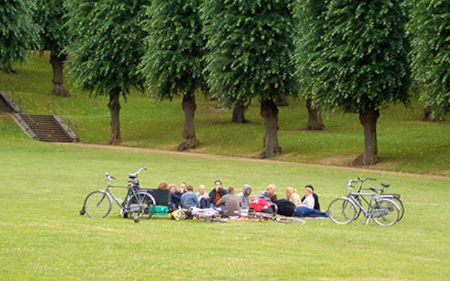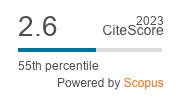Perception and value of nature in urban landscapes: A comparative analysis of cities in Germany, Chile and Spain
DOI:
https://doi.org/10.3097/LO.200807Keywords:
Inter-cultural comparison, Social groups and acceptance of urban nature, Utilization of urban greenAbstract
Cities are not socially homogenous, but divided into socially and structurally differentiated sub-units. Likewise, the individuals of a community, city or neighbourhood present specific behavioural patterns and uses with respect to their public green areas. This premise has led us to explore the question of how the perceptions, uses, and behaviours of people from different countries, cultures, and socioeconomic levels in Chile, Germany and Spain differ or coincide as far as urban nature and landscapes are concerned. Due to the comparative nature of the project, research areas with similar characteristics were chosen, thus allowing a comparative analysis of upper and lower middle-class neighbourhoods. People from all six study areas were surveyed using the same questionnaires. The results revealed that people of different social and cultural backgrounds use and perceive urban landscape in different ways. We found that nature of different kind plays an important role in all the urban societies and particularly in the neighbourhoods studied, regardless of social status or nationality. However, the higher the social status, the greater the urban green area dedicated to private uses. The preference for specific types of nature depends not only on social status, but cultural elements, accessibility and tradition as well. Moreover, nature-related outdoor activities are defined by this status, in turn reflecting the individual's cultural status within society.
References
Abdullah Eben Saleh, M. (1999). Reviving traditional design in modern saudi arabia for social cohesion and crime prevention purposes. Landscape and Urban Planning, 44(1), 43-62. doi:10.1016/S0169-2046(98)00107-8
Abu-Ghazzeh, T. M. (1996). Reclaiming public space: The ecology of neighborhood open spaces in the town of abu-nuseir, jordan. Landscape and Urban Planning, 36(3), 197-216. doi:10.1016/S0169-2046(96)00343-X
Akbari, H., Davis, S., Dorsano, S., Huang, J., & Winnett, S. (1992). Cooling our communities: A guidebook on tree planting and light-colored surfacing. Cooling our Communities: A Guidebook on Tree Planting and Light-Colored Surfacing,
Al-Hathloul, S., & Mughal, M. A. (1999). Creating identity in new communities: Case studies from saudi arabia. Landscape and Urban Planning, 44(4), 199-218. doi:10.1016/S0169-2046(99)00010-9
Anderson, L. M., & Cordell, H. K. (1988). Influence of trees on residential property values in athens, georgia (U.S.A.): A survey based on actual sales prices. Landscape and Urban Planning, 15(1-2), 153-164. doi:10.1016/0169-2046(88)90023-0
Austin, M. E. (2004). Resident perspectives of the open space conservation subdivision in hamburg township, michigan. Landscape and Urban Planning, 69(2-3), 245-253. doi:10.1016/j.landurbplan.2003.09.007
Baker, L. A., Hope, D., Xu, Y., Edmonds, J., & Lauver, L. (2001). Nitrogen balance for the central arizona-phoenix (CAP) ecosystem. Ecosystems, 4(6), 582-602. doi:10.1007/s10021-001-0031-2
Balram, S., & Dragićević, S. (2005). Attitudes toward urban green spaces: Integrating questionnaire survey and collaborative GIS techniques to improve attitude measurements. Landscape and Urban Planning, 71(2-4), 147-162. doi:10.1016/S0169-2046(04)00052-0
Barnhart, S. K., H. Perkins, N., & Fitzsimonds, J. (1998). Behaviour and outdoor setting preferences at a psychiatric hospital. Landscape and Urban Planning, 42(2-4), 147-156. doi:10.1016/S0169-2046(98)00083-8
Beer, A. R. (1994). Urban greenspace and sustainability. Sustainable Urban Development: Research and Experiments, , 69-88.
Berg, P. G. (2004). Sustainability resources in swedish townscape neighbourhoods: Results from the model project hågaby and comparisons with three common residential areas. Landscape and Urban Planning, 68(1), 29-52. doi:10.1016/S0169-2046(03)00117-8
Berman, L. (1997). How does our Garden Grow? A Guide to Community Garden Success,
Breuste, J., Rojas Hernandez, J., Kasperidus, H. D., & Priego, C. (2003). Utilización y maneja de la naturaleza y del pajsaje en aglomeraciones urbanas.36, 194.
Breuste, J., & Wohlleber, S. (1998). Naturschutz und landschaftspflege in urbanen kulturlandschaften leipzigs. Zeitschrift Für Den Erdkundeunterricht, 50, 215-225.
Brunson, L., Kuo, F. E., & Sullivan, W. C. (2001). Resident appropriation of defensible space in public housing: Implications for safety and community. Environment and Behavior, 33(5), 626-652. doi:10.1177/00139160121973160
Chenoweth, R. E., & Gobster, P. H. (1990). The nature and ecology of aesthetic experiences in the landscape. Landscape Journal, 9(1), 1-8.
Chiesura, A. (2004). The role of urban parks for the sustainable city. Landscape and Urban Planning, 68(1), 129-138. doi:10.1016/j.landurbplan.2003.08.003
Coles, R. W., & Bussey, S. C. (2000). Urban forest landscapes in the UK - progressing the social agenda. Landscape and Urban Planning, 52(2-3), 181-188. doi:10.1016/S0169-2046(00)00132-8
Crow, T., Brown, T., & De Young, R. (2006). The riverside and berwyn experience: Contrasts in landscape structure, perceptions of the urban landscape, and their effects on people. Landscape and Urban Planning, 75(3-4), 282-299. doi:10.1016/j.landurbplan.2005.04.002
Damigos, D., & Kaliampakos, D. (2003). Assessing the benefits of reclaiming urban quarries: A CVM analysis. Landscape and Urban Planning, 64(4), 249-258. doi:10.1016/S0169-2046(02)00243-8
Dökmeci, V., & Berköz, L. (2000). Residential-location preferences according to demographic characteristics in istanbul. Landscape and Urban Planning, 48(1-2), 45-55. doi:10.1016/S0169-2046(99)00080-8
Douglas, I. (1983). The urban environment. The Urban Environment.,
Dwyer, J. F., McPherson, E. G., Schroeder, H. W., & Rowntree, R. A. (1992). Assessing the benefits and costs of the urban forest. Journal of Arboriculture, 18(5), 227-234.
Dwyer, J. F., & Schroeder, H. W. (1994). The human dimensions of urban forestry. Journal of Forestry, 92(10), 12-15.
Ellis, C. D., Lee, S. -., & Kweon, B. -. (2006). Retail land use, neighborhood satisfaction and the urban forest: An investigation into the moderating and mediating effects of trees and shrubs. Landscape and Urban Planning, 74(1), 70-78. doi:10.1016/j.landurbplan.2004.10.004
Fjørtoft, I., & Sageie, J. (2000). The natural environment as a playground for children. landscape description and analyses of a natural playscape. Landscape and Urban Planning, 48(1-2), 83-97. doi:10.1016/S0169-2046(00)00045-1
Friedrichs, J. (1990). Methoden Empirischer Sozialforschung,
García, F. (1993). , 1-25.
Gobster, P. H. (1995). Perception and use of a metropolitan greenway system for recreation. Landscape and Urban Planning, 33(1-3), 401-413. doi:10.1016/0169-2046(94)02031-A
Gobster, P. H. (1998). Urban parks as green walls or green magnets? interracial relations in neighborhood boundary parks. Landscape and Urban Planning, 41(1), 43-55. doi:10.1016/S0169-2046(98)00045-0
Gobster, P. H. (2001). Visions of nature: Conflict and compatibility in urban park restoration. Landscape and Urban Planning, 56(1-2), 35-51. doi:10.1016/S0169-2046(01)00164-5
Hörnsten, L., & Fredman, P. (2000). On the distance to recreational forests in sweden. Landscape and Urban Planning, 51(1), 1-10. doi:10.1016/S0169-2046(00)00097-9
Hough, M. (1984). City Form and Natural Process,
Jacobs, J. (1961). The Death and Life of Great American Cities,
Jim, C. Y., & Chen, W. Y. (2006). Recreation-amenity use and contingent valuation of urban greenspaces in guangzhou, china. Landscape and Urban Planning, 75(1-2), 81-96. doi:10.1016/j.landurbplan.2004.08.008
Kaplan, R. (1992). Urban forestry and the workplace. Managing Urban and High-use Recreation Settings, , 41-45.
Kaplan, R., & Austin, M. E. (2004). Out in the country: Sprawl and the quest for nature nearby. Landscape and Urban Planning, 69(2-3), 235-243. doi:10.1016/j.landurbplan.2003.09.006
Kromrey, H. (2006). Empirische Sozialforschung,
Kuo, F. E., Bacaicoa, M., & Sullivan, W. C. (1998). Transforming inner-city landscapes: Trees, sense of safety, and preference. Environment and Behavior, 30(1), 28-59. doi:10.1177/0013916598301002
Kuo, F. E., & Sullivan, W. C. (2001). Environment and crime in the inner city does vegetation reduce crime? Environment and Behavior, 33(3), 343-367. doi:10.1177/00139160121973025
Kuo, F. E., Sullivan, W. C., Coley, R. L., & Brunson, L. (1998). Fertile ground for community: Inner-city neighborhood common spaces. American Journal of Community Psychology, 26(6), 823-851. doi:10.1023/A:1022294028903
Lewis, C. -. (1992). Effects of Plants and Gardening in Creating Interpersonal and Community Well-being,
Lewis, C. -. (1996). Green nature. Human Nature: The Meaning of Plants in our Lives,
Lindsey, G. (1999). Use of urban greenways: Insights from indianapolis. Landscape and Urban Planning, 45(2-3), 145-157. doi:10.1016/S0169-2046(99)00023-7
Lucy, W. H., & Phillips, D. L. (1997). The post-suburban era comes to richmond: City decline, suburban transition, and exurban growth. Landscape and Urban Planning, 36(4), 259-275. doi:10.1016/S0169-2046(96)00358-1
MacDonald, L. (1996). Global problems local solutions. Amer Forests, 102(4), 26-32.
Matsuoka, R. H., & Kaplan, R. (2008). People needs in the urban landscape: Analysis of landscape and urban planning contributions. Landscape and Urban Planning, 84(1), 7-19. doi:10.1016/j.landurbplan.2007.09.009
McDonnell, M. J., Pickett, S. T. A., Groffman, P., Bohlen, P., Pouyat, R. V., Zipperer, W. C., . . . Medley, K. (1997). Ecosystem processes along an urban-to-rural gradient. Urban Ecosystems, 1, 21-36.
Nowak, D. J., Civerolo, K. L., Trivikrama Rao, S., Sistla, G., Luley, C. J., & Crane, D. E. (2000). A modeling study of the impact of urban trees on ozone. Atmospheric Environment, 34(10), 1601-1613. doi:10.1016/S1352-2310(99)00394-5
Oguz, D. (2000). User surveys of ankara's urban parks. Landscape and Urban Planning, 52(2-3), 165-171. doi:10.1016/S0169-2046(00)00130-4
Oku, H., & Fukamachi, K. (2006). The differences in scenic perception of forest visitors through their attributes and recreational activity. Landscape and Urban Planning, 75(1-2), 34-42. doi:10.1016/j.landurbplan.2004.10.008
Owens, P. M. (1993). Neighborhood form and pedestrian life: Taking a closer look. Landscape and Urban Planning, 26(1-4), 115-135. doi:10.1016/0169-2046(93)90011-2
Özgüner, H., & Kendle, A. D. (2006). Public attitudes towards naturalistic versus designed landscapes in the city of sheffield (UK). Landscape and Urban Planning, 74(2), 139-157. doi:10.1016/j.landurbplan.2004.10.003
Pacione, M. (1982). The use of objective and subjective measures of life quality in human geography. Progress in Human Geography, 6(4), 495-514. doi:10.1177/030913258200600402
Peck, S. W., Callaghan, C., Kuhn, M. E., & Bass, B. (1999). Greenbacks from green roofs: Forging a new industry in canada. Greenbacks from Green Roofs: Forging a New Industry in Canada,
Puddifoot, J. E. (1996). Some initial considerations in the measurement of community identity. Journal of Community Psychology, 24(4), 327-336. doi:10.1002/(SICI)1520-6629(199610)24:4<327::AID-JCOP3>3.3.CO;2-L
Rohde, C. L. E., & Kendle, A. D. (1994). Report to English Nature-Human Well-being, Natural Landscapes and Wildlife in Urban Areas: A Review,
Roovers, P., Hermy, M., & Gulinck, H. (2002). Visitor profile, perceptions and expectations in forests from a gradient of increasing urbanisation in central belgium. Landscape and Urban Planning, 59(3), 129-145. doi:10.1016/S0169-2046(02)00011-7
Santibáñez, F., & Uribe, J. (1993). Atlas Agroclimático De La V Región Y Región Metropolitana,
Savard, J. -. L., Clergeau, P., & Mennechez, G. (2000). Biodiversity concepts and urban ecosystems. Landscape and Urban Planning, 48(3-4), 131-142. doi:10.1016/S0169-2046(00)00037-2
Sebba, R. (1991). The landscapes of childhood: The reflection of childhood's environment in adult memories and in children's attitudes. Environment and Behavior, 23(4), 395-422. doi:10.1177/0013916591234001
Seila, A. F., & Anderson, L. M. (1982). Estimating costs of tree preservation on residential lots. Journal of Arboriculture, 8(7), 182-185.
Shafer, C. S., Lee, B. K., & Turner, S. (2000). A tale of three greenway trails: User perceptions related to quality of life. Landscape and Urban Planning, 49(3-4), 163-178. doi:10.1016/S0169-2046(00)00057-8
Sherman, S. A., Varni, J. W., Ulrich, R. S., & Malcarne, V. L. (2005). Post-occupancy evaluation of healing gardens in a pediatric cancer center. Landscape and Urban Planning, 73(2-3), 167-183. doi:10.1016/j.landurbplan.2004.11.013
Simson, A. J. (2000). The post-romantic landscape of telford new town. Landscape and Urban Planning, 52(2-3), 189-197. doi:10.1016/S0169-2046(00)00133-X
Stewart, W. P., Liebert, D., & Larkin, K. W. (2004). Community identities as visions for landscape change. Landscape and Urban Planning, 69(2-3), 315-334. doi:10.1016/j.landurbplan.2003.07.005
Sukopp, H., & Werner, P. (1983). Urban environments and vegetation. Man's Impact on Vegetation, , 247-260.
Tyrväinen, L., & Väänänen, H. (1998). The economic value of urban forest amenities: An application of the contingent valuation method. Landscape and Urban Planning, 43(1-3), 105-118. doi:10.1016/S0169-2046(98)00103-0
Ulrich, R. S. (1984). View through a window may influence recovery from surgery. Science, 224(4647), 420-421. doi:10.1126/science.6143402
Ulrich, R. S. (1979). Visual landscapes and psychological weil-being. Landscape Research, 4(1), 17-23. doi:10.1080/01426397908705892
Vogt, C. A., & Marans, R. W. (2004). Natural resources and open space in the residential decision process: A study of recent movers to fringe counties in southeast michigan. Landscape and Urban Planning, 69(2-3), 255-269. doi:10.1016/j.landurbplan.2003.07.006
Yabes, R., Shetter, K., & Schneeman, J. (1997). Urban waterways: Changing historical uses and users in a southwestern desert city. Landscape and Urban Planning, 39(2-3), 167-185. doi:10.1016/S0169-2046(97)00053-4

Downloads
Published
How to Cite
Issue
Section
License
Copyright (c) 2019 Carlos Priego, Jürgen Breuste, Jorge Rojas

This work is licensed under a Creative Commons Attribution 4.0 International License.










